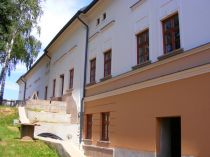Keresés
Borsod-Abaúj-Zemplén county
Abaújkér Bárczay-mansion
Abaújszántó Patay-mansion
Bánhorváti Platthy-mansion
Bánréve Vay-Serényi-mansion
Bodrogolaszi Lónyay-mansion
Boldogkőváralja Péchy-Zichy-mansion
Bózsva Bombelles-mansion ruin
Dubicsány Vay-castlehotel
Edelény L'Huillier-Coburg castle
Emőd Rhédey-mansion
Erdőbénye Szirmay-mansion
Fáj Fáy-mansion
Felsővadász Rákóczi-mansion
Felsőzsolca Bárczay-mansion
Füzérradvány Károlyi-mansion
Galvács Törley-mansion
Girincs Dőry-mansion
Golop Vay-mansion
Gönc Pálffy-mansion
Györgytarló Györgytarlói mansion
Hejce Hejceimansion vagy más néven Eszterházy- Püspöki-mansion
Hernádvécse Sardagna-mansion
Kéked Melczer-castlehotel
Krasznokvajda Szentimrey-mansion
Scholtz-Albin-mansion
Kurityán Pallavicini-mansion
Mezőcsát Dobozy-mansion , Márk-mansion , Édes-mansion
Miskolc Bárczay-mansion Miskolc huntingseat
Monok Andrássy-mansion
Monok castlehotel
Nagyhuta hunting-seat. hotel
Pácin Pácini castle-museum
Pere Bárczay-mansion
Pusztaradvány Pallavicini-castlehotel
Putnok Serényi-mansion
Ragály Balassa-mansion
Sajókaza Radvánszky-mansion
Sajólád Erdődy-huntigseat
Sály Eötvös-Gorove-mansion
Sárospatak castle,mansion
Sáta Fáy-mansion
Sátoraljaújhely Waldbott-mansion , Szirmay-mansion
Szalaszend Hönig-mansion
Szalonna Bónis-Gedeon mansion
Szemere Szemere-mansion
Szendrő Csáky-mansion
Szerencs Rákóczi-castle
Szikszó Csáky-Hunyady-mansion
Szirmabesenyő Szirmay-mansion
Taktabáj Patay-mansion
Tarcal Degenfeld-mansion
Tállya Maillot-mansion
Telkibánya Károlyi-huntingseat
Tibolddaróc Bottlik-mansion
Tokaj Rákóczi-Dessewffy mansion
Tolcsva Kurucz-mansion
Tolcsva Szirmay-mansion Tolcsva Dessewffy-mansion , Rákóczi-mansion
Tornanádaska Hadik-mansion
Tornyosnémeti Csáky-Pallavicini mansion
Vatta Odescalchi-mansion
|
Patay-mansion |
|
 |
|
|
Bárczay-mansion |
|
 |
|
|
Platthy-mansion |
|
 |
|
|
Vay-Serényi-mansion |
|
 |
|
|
Lónyai-mansion |
|
 |
|
|
Péchy-Zichy-mansion |
|
 |
|
|
Bombelles-mansion |
|
 |
|
|
Károlyi-castle |
|
 |
|
| Füzérradvány, Károlyi House Although the exterior of the Károlyi House, which is surrounded by the woods of Füzérradvány, recalls a romantic atmosphere, one can find a genuine Italian renaissance milieu in its splendid rooms. Its beautiful stone-carvings, marble fireplaces, door posts, and embossments that used to decorate Italian renaissance palaces were made by 16th- and 17th-century Florentine maestri. At the end of the 19th century, László Károlyi, the lord of the House, and his wife decided to change their home into a genuine renaissance style. They collected renaissance and baroque pieces of decoration and furniture for almost two decades. They bought articles usually from one of the most famous antiquaries of the time: among them were stone carvings (which were built in the walls of the House), fireplaces, and also furniture and articles for personal use, which were also genuine Italian renaissance works of art. Unfortunately, several of these were lost after the Second World War; however, some were brought back in the 1990s when the castle was reopened for visitors. On the first floor of the House, which is being renovated at the moment, one can find rooms (the former kitchen, the dining room, the salon and the bedroom of the count, and the bathroom with a marble pool) the interior of which recalls an atmosphere of the aristocratic world. | |
|
Vay-castlehotel |
|
 |
|
|
L'Hullier-Coburg mansion |
|
 |
|
| The L'Huillier-Coburg Palace in Edelény was built by Ferenc János L'Huillier, who was born in Alsace-Lorraine. It is the seventh-largest palace in Hungary. Built between 1716 and 1730, it is this country's pre-eminent example of early-baroque architecture. The palace is U-shaped, with a three-storeyed, flat-roofed central wing - flanked by cylindrical towers at the corners - and two single-storeyed, mansard roofed, side wings. The central wing overlooks the front courtyard, which is surrounded by single-storey ancillary buildings, and access to which is provided through a large-sized, finely-wrought iron gate, bearing a coat-of-arms. The courtyard contains a few trees and some trimmed hedges. | |
| Szirmay-mansion |
|
 |
|
|
Fay-mansion |
|
 |
|
| Fáj, Fáy House While planning the mansion built in the Cserehát Hills, the shape of the terrain was exploited in an interesting way, which resulted in a partly one-storey, partly two-storey building. The House, which was built in the middle of the 18th century by the Fáy family, was rebuilt in classicist style in the 19th century, and later it was transformed into neo-baroque style; thus, the various architectural trends of different ages combine into an exciting result. In its partly restored rooms, one can see several genuine ceramic stoves, and in the great hall, there are large pieces of stuccos made by an Italian sculptor, Marco Casagrande, between 1844 and 1845. The partly furnished building welcomes visitors in the summer. | |
|
Rákóczi-mansion |
|
 |
|
|
Bárczay-mansion |
|
 |
|
|
Törley-mansion |
|
 |
|
|
Dőry-mansion |
|
 |
|
|
Pállfy-mansion |
|
 |
|
|
Kőkapu-castlehotel |
|
 |
|
|
Püspöki-mansion |
|
 |
|
|
Sardagna-mansion hotel |
|
 |
|
|
Melczer-castlehotel |
|
 |
|
|
Szentimrey-mansion |
|
 |
|
|
Bodrogközi-castle |
|
 |
|
|
Pallavicini-mansion |
|
 |
|
|
Dobozy-mansion |
|
 |
|
|
Bárczay-mansion |
|
 |
|
|
Andrássy-mansion |
|
 |
|
| Monoki-castlehotel |
|
 |
|
|
Pallavicini-castlehotel |
|
 |
|
|
Serényi-mansion |
|
 |
|
|
Balassa-mansion |
|
 |
|
|
Radvánszky-mansion |
|
 |
|
|
Rákóczi-castle |
|
 |
|
|
Fay-mansion |
|
 |
|
|
Eötvös-Gorove-mansion |
|
 |
|
| Waldbott-mansion |
|
 |
|
| Gedeon-mansion |
|
 |
|
|
Pallavicini-mansion |
|
 |
|
|
Csáky-mansion |
|
 |
|
|
Csáky-Hunyadi-mansion |
|
 |
|
|
Patai-mansion |
|
 |
|
|
Degenfeld-mansionhotel |
|
 |
|
|
Bottlik-mansion |
|
 |
|
|
Rákóczi-Dessewffy-mansion |
|
 |
|
|
|
|
 |
|
|
Rákóczi-mansion |
|
 |
|
|
Hadik-mansion |
|
 |
|
|
Odeschalchi-mansion |
|
 |
|